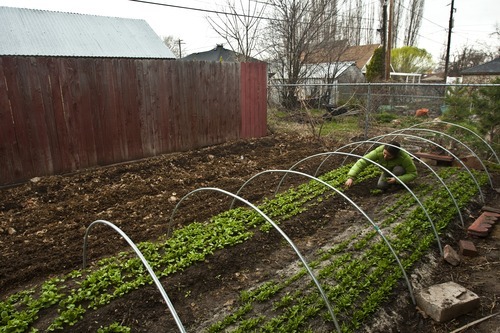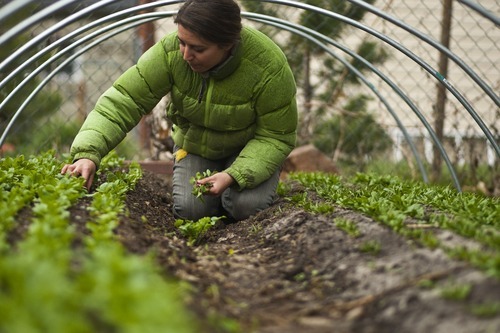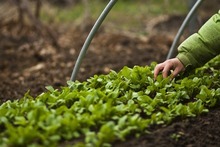This is an archived article that was published on sltrib.com in 2011, and information in the article may be outdated. It is provided only for personal research purposes and may not be reprinted.
Sharon Leopardi doesn't own farmland, tractors or other hefty agricultural equipment, and the 24-year-old still rents an apartment.
Yet this innovative University of Utah graduate is making a living as a full-time farmer as the owner of B.U.G. Farms. Those abbreviated letters stand for Backyard Urban Garden, which is what she borrows from homeowners throughout Salt Lake City to run her business.
In return for sharing the yard — and paying irrigation costs — the land owner gets a portion of the produce that Leopardi grows.
The rest of the fruits, vegetables and herbs that she harvests are delivered to shareholders in her Community Supported Agriculture program.
There are only a few weeks left to sign up for CSAs such as Leopardi's and Utah consumers might be surprised at the number of farms that participate.
"In 2003, we started with 4 or 5, and today we have close to 30," says Jeff Williams with CSA Utah.
A CSA is a good option for people who want to encourage sustainable farming and who want to make a long-term commitment to eating locally grown produce.
Here's how it works: Individuals or families pay a fee in the spring to become a member or "shareholder" of a local farm. The cash allows farmers to prepare the soil, buy seeds or purchase equipment to produce their crops. In return, shareholders receive a weekly portion of the farm's bounty, usually from the end of May through October. Most farmers have several drop-off locations to make it more convenient for members to pick up their produce.
—
Youngest CSA • While there are nearly three dozen CSA options, Leopardi's may be the state's most unique simply because she is a young person farming. But creativity makes her a standout as well.
"She's utilizing space that typically wouldn't be used for food production," Williams said.
Leopardi started B.U.G. Farms last year. Like most people her age, she had to think beyond a traditional farm, because she didn't inherit family land and didn't have money to buy any acreage.
Instead, she borrowed space in four backyards, about 1/8th of an acre in total. She has expanded for the 2011 growing season: This year she will have almost 1 acre of growing space in eight different yards. She has also hired two employees.
Last year, Leopardi planted 15 kinds of tomatoes, while this year she plans to grow 40 varieties. She is also planning several other crops, including leafy greens, carrots, summer and winter squash, plus dried Anasazi beans.
This year, she also is adding about 100 chickens to her urban farming. The birds will rotate around the yards to eat insects, fertilize crops and provide CSA members with eggs.
Because of the low start-up costs, Leopardi said this kind of Small Plot Intensive — or SPIN farming system — has become a national trend. It's a way of growing a lot of food in a small space, she said. And it's allowing a new generation of people to become farmers.
Janean Parker loaned Leopardi her backyard last year and is excited do it again. "It's a little strange at first," said the graphic designer, "but when all the vegetables are growing, the yard is so lush and green."
Parker had previously been paying someone to mow her lawn, so the garden saved her that expense. Plus she gets one of Leopardi's CSA shares, worth $600. (Half shares are $350.) Watering the garden is about the same cost as watering a lawn, she said, especially since Leopardi uses a water-efficient drip irrigation system.
"Before we did this, we weren't big vegetable eaters," Parker said of herself and her boyfriend. "But getting a delivery every week has really been helpful. We've learned to make the most amazing salads and we're eating chard and kale, things we had never eaten before ."
—
Getting started • With parents who served in the Air Force, Leopardi lived in several states as a child. She had extended family in Utah and moved here to attend the U., where she earned a degree in geography and environmental studies. "I always wanted to have a job working outside," she said.
Working in the community garden on the U. campus is "what motivated me to try farming." The day after graduation, she moved to southern Utah, where she worked at the Mesa Farm Market.
Later, she returned to Salt Lake City to work for Wasatch Community Gardens. At the local nonprofit, she was introduced to the urban farming movement. "That's when I realized I could have a business growing food," she said.
Leopardi said Salt Lake City is a perfect place for her business since the city designers created residential blocks with deep backyards for gardens and small farms.
"I'm not really doing anything new," she said. "I'm just doing it a different way than it has been done before."
Community Supported Agriculture in Utah
Here is a list of the CSAs in Utah. Details on prices, delivery dates and what each farm provides is available by contacting individual farms or through the CSAUtah website: http://www.csautah.org/find-a-csa. Most CSAs have drop off points in several locations throughout the valley
3 Squares Produce • Salt Lake City; 801-243-2801 or http://www.3squaresproduce.com/csa
Appenzell Farm • Hyde Park; 435-535-1121 or http://www.appenzellfarm.com
Backyard Urban Garden (B.U.G.) Farms • Salt Lake City; 801 718-7478 or http://www.backyardurbangardens.com
Bell Organic Gardens • Draper; 801-571-7288 or http://www.bellorganic.com
Black Island Farms • Syracuse; 801-774-6293 or http://www.blackislandfarms.com
Blue Spring Farm • Tremonton; 435-279-0563
Borski Farms • Kaysville; 801-941-9620 or http://www.borskifarms.org
Bryan Palmer • Wellsville; http://www.csautah.org/find-a-csa
Chad's Produce • West Bountiful; http://www.csautah.org/find-a-csa
Christiansen Family Farm • Vernon; 435-839-3482 or http://www.christiansenfarm.com
Copper Moose Farm • Park City; 435-604-0497 or http://www.coppermoosefarm.com
Cricket Song Farm • Beryl; 435-630-6587
East Farms • West Point; 801-525-2219 or http://www.eastfarmscsa.com
Food Connect • Brisbane, http://www.foodconnect.com
Heritage Valley Poultry • Tremonton; 435-770-2365
Jacob's Cove Heritage Farms • Pleasant Grove; 801-787-4830
Joseph's Naturally Grown Farm-Garden • Paradise; 435-237-9112 or http://garden.lofthouse.com
Late Bloomin' Heirlooms • West Jordan; 801-664-9352.
Lau Family Farm • Soda Springs, Idaho; 208-547-3180 or http://www.laufamilyfarm.com
Liberty Heights Fresh • Salt Lake City; 801. 583-7374 or http://libertyheightsfresh.com
Little America Organic Orchard • New Harmony; 435-867-4532
Live and Thrive • Holladay; 801-278-5313 or http://liveandthrive.com/Gardening/Local_Community_Gardening/Home
Peacefield Farm • Cedar City, 801-865-7540 or http://www.peacefieldfarm.net
Ranui Gardens •Dog Holler, http://www.ranui.com
Red Acre Farm • Cedar City, 435-865-6792
Roberts Ranch and Gardens • Spanish Fork, 801-836-0232 or http://robertsranch.org
Sandhill Farms • Eden, 801-866-3620 or http://www.sandhillfarms.org
Sol Food Farms • Moab, 435-260-8287 or http://www.solfoodfarms.com
Sun River Farms • Mendon; 435-757-7507
Tagge's Famous Fruit • Perry or http://www.taggesfamousfruit.com
Tveit Gardens • Nibley; 435-770-8714
Youth Garden Project • Moab, 435-259-2326 or http://www.youthgardenproject.org
Zoe's Garden • Layton; 801-721-8238 or http://www.zoegarden.com —
How a CSA works
Individuals or families pay a fee in the spring to become a member or "shareholder" of a Community Supported Agriculture program. The cash allows farmers to prepare the soil, buy seeds or purchase equipment to produce their crops. In return, shareholders receive a weekly portion of the farm's bounty, usually from the end of May through October. Most farmers have several drop off locations to make it more convenient for members to pick up their produce. —
Crispy kale chips
6 to 8 cups fresh kale, stems removed
2 tablespoons olive oil
1/2 teaspoon kosher salt
1/2 teaspoon grated Parmesan cheese
Heat oven to 350 degrees. Place parchment paper on cooking sheet. If kale leaves are large, cut in half. Spread kale on cookie sheet. Drizzle with olive oil and toss to coat. Place on lowest oven rack and bake for 10 minutes. Turn and bake additional 10 minutes. Chips should be lightly brown and crisp. Remove from oven and immediately sprinkle with salt and cheese.
Servings • 4
Source: Sharon Leopardi, B.U.G. Farms —
Lentil and spinach puffs
3/4 cup dried small red lentils
3 1/2 cups washed and coarsely chopped spinach
2 green onions, thinly sliced
1 tablespoon finely chopped fresh cilantro
1 tablespoon finely chopped chile
1 clove garlic, minced
2 teaspoons all-purpose flour
3/4 teaspoons salt
1/8 teaspoon baking powder
Peanut oil for frying
Chutney, for garnish
Sort and wash lentils. Place in a pot and add enough water so it reaches a couple inches above the lentils. Soak 8 hours or overnight. Drain.
Place lentils and 3 tablespoons water in food processor, processing until smooth. Combine lentils, with chopped spinach, green onions, cilantro, chile and garlic. Stir in all-purpose flour, salt and baking powder.
Heat a little bit of oil in a large non-stick skillet. Scoop several tablespoon-size balls of the lentil/spinach mixture into the heated pan. Cook until crisp, about two minutes. Turn and cook two minutes more. Remove puffs from pan and drain on paper towels. Keep warm. Repeat process until all the lentil/spinach mixture is cooked.
Serve puffs topped with chutney.
Servings • 3-4
Source: Sharon Leopardi, B.U.G. Farms











